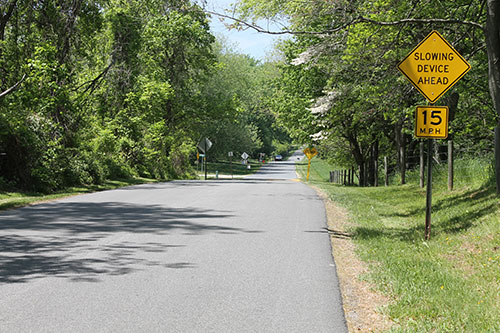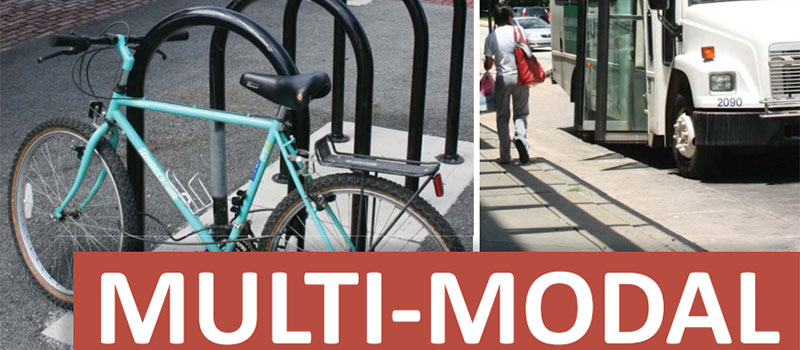Traffic Calming (Residential Street Controls)
Traffic Calming
"The combination of mainly physical measures that reduce the negative effects of motor vehicle use, alter driver behavior, and improve conditions for non-motorized street users."
— Institute of Transportation Engineers (ITE)
Standards
The following is an excerpt from Pennsylvania's Traffic Calming Handbook, (PennDOT Pub 383):
When Is Traffic Calming Appropriate?
Using a well-defined "Traffic Calming Study and Approval Process" will help determine when and where traffic calming measures are appropriate. Because traffic calming measures have the potential to create controversy, their installation often occurs as the final step of a three-step process referred to as the "three E's" (education, enforcement, and engineering). However, this three-step process only addresses problems with speeding, not with cut-through volumes. If the first two steps are not effective in lowering speeds on neighborhood streets, the need for traffic calming measures becomes more apparent.
Education
Communities with educational programs seek to remind speeding drivers of the negative effects of their actions, often by stressing that the community's children are the most at risk. Educational campaigns may use brochures or neighborhood newsletters to spread this message. Newsletters may also contain information on speeding fines (particularly in school zones), pedestrian and bicycle safety tips, and information on average speeds in the neighborhood.
Enforcement
Enforcement involves a more intensive police presence and a greater allocation of time to enforcing the speed limit in a particular neighborhood. Unfortunately, it is often not practicable to maintain a police presence at the level needed to permanently lower speeds. However, consistent visible enforcement does lead to respect of the speed limit by motorists.
Engineering
Engineering includes, but is not limited to, traffic calming measures. It can also include the use of signs and pavement markings to obtain the desired effect. Prior to installing traffic calming measures on local or collector streets, traffic conditions on adjacent arterial streets should be investigated to determine if operational deficiencies are contributing to the identified traffic concerns. If the adjacent arterial streets are the responsibility of the local government, these deficiencies should be addressed before traffic calming is considered. In addition, when the use of traffic calming measures may divert large volumes of traffic from local streets, the effects on adjacent roadways should be addressed.
Where are Traffic Calming Measures Appropriate?
As outlined in the "Traffic Calming Study and Approval Process", functional classification and land use should be primary criteria in determining whether traffic calming measures are appropriate for a particular roadway. When conditions warrant, traffic calming measures may be appropriate on the following roadway types (local or State-owned):
- Local residential streets
- Collector streets with predominantly residential land uses
- Arterial roads within downtown districts or commercial areas (with posted speeds of 40 mph or less)
Traffic calming measures addressed in the PennDOT handbook include:
- Curb Extensions / Bulb-Outs
- Chicanes
- Gateways
- On-Street Parking
- Traffic Circles
- Roundabouts
- Speed Humps
- Speed Cushions/Speed Pillows
- Raised Intersections
- Diagonal Diverters
- Right-In / Right-Out Island
- Raised Median Through Intersection
- Street Closures
- Pedestrian Safety Enhancement Devices
Comments
The first function of residential streets is to serve abutting properties. They provide access to homes by all who enter and leave, make deliveries and provide services. A secondary function is to provide routes for those who wish only to pass through the area. Residential streets offer opportunities to provide landscaped vistas, trees, shrubs, paths for walking and rights-of-way for utilities. Basic conflict arises due to the discrepancy between the impact of vehicular traffic and the tranquility of residential streets.
When considering the use of residential street controls, residents should be included in the process. Residents will determine the needs and priorities of the neighborhood. Their response to the proposed plans and the ultimate approval will be important in implementing the plan.

Traffic calming measures
Recommendations
- Follow the recommendations contained in PennDOT Publication 383, Pennsylvania's Traffic Calming Handbook.
- Evaluate existing conditions relative to community needs and desires;
- Allow traffic implications to be evaluated by a traffic engineer to determine the appropriate control; and,
- Municipalities should seek professional advice to avoid liability issues.


